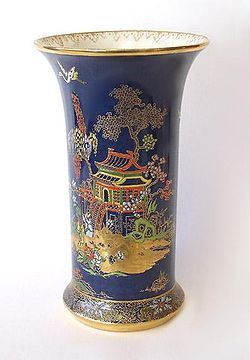
Carlton Ware
Encyclopedia

Stoke-on-Trent
Stoke-on-Trent , also called The Potteries is a city in Staffordshire, England, which forms a linear conurbation almost 12 miles long, with an area of . Together with the Borough of Newcastle-under-Lyme Stoke forms The Potteries Urban Area...
based pottery manufacturer. The company is best remembered for its often rather garish tableware, often in the form of highly decorated leaves or fruit, and the ceramic toucans it made as promotional items for Guinness
Guinness
Guinness is a popular Irish dry stout that originated in the brewery of Arthur Guinness at St. James's Gate, Dublin. Guinness is directly descended from the porter style that originated in London in the early 18th century and is one of the most successful beer brands worldwide, brewed in almost...
. It reached its artistic high-point with superb hand-painted domestic pottery in high art deco
Art Deco
Art deco , or deco, is an eclectic artistic and design style that began in Paris in the 1920s and flourished internationally throughout the 1930s, into the World War II era. The style influenced all areas of design, including architecture and interior design, industrial design, fashion and...
styles during the 1920s and 1930.
History
The company was established in 1890 by James Frederick Wiltshaw, William Herbert Robinson and James Alcock Robinson trading under the name of Wiltshaw and Robinson. The trademark "Carlton Ware" was introduced in 1894, and the company's factory was renamed the Carlton Works.In 1911 the business partnership between Wiltshaw and the Robinsons was dissolved, leaving Wiltshaw to form a new limited company called Wiltshaw and Robinson Limited. Following the death of James Wiltshaw in 1918, due to an accident at Stoke-on-Trent railway station
Stoke-on-Trent railway station
Stoke-on-Trent Railway Station is a main-line railway station in central England. It is located on the Stafford to Manchester branch of the West Coast Main Line and serves the Staffordshire city of Stoke-on-Trent...
, control of the company passed to his son Frederick Cuthbert Wiltshaw. The company continued to expand, acquiring Birks, Rawlins and Co. in 1930.
The company was renamed Carlton Ware Limited in 1958, and following the death of Frederick Cuthbert Wiltshaw in 1966, the company was sold to Arthur Wood and Sons. The company continued to trade well until developing serious financial difficulties in the late 1980s, which forced it into receivership in 1989. An unsuccessful attempt was then made to rescue the company by Grosvenor Ceramic Hardware, with production finally ending in 1992.
In 1997 the Carlton Ware brand was resurrected by Francis Joseph of the Carlton Ware Design Centre, Roslyn Works, Stoke-on-Trent. It continues to manufacture novelty items aimed at the collectors' market.
Products

Decal
A decal or transfer is a plastic, cloth, paper or ceramic substrate that has printed on it a pattern or image that can be moved to another surface upon contact, usually with the aid of heat or water. The word is short for decalcomania...
and hand-painted table-ware in a range of mostly floral patterns as well as items inspired by Wedgewood and other respected potters. During the early 1900s they became a supplier of "crested ware" for the tourist market.
During the 1920s the company introduced new methods of production where the decal and hand-painting work was applied to high-glaze substrates. Amongst the first of these were a series of designs inspired by the artwork discovered in Tutankhamen's tomb, which can be fairly said to represent the beginning of the art deco pottery movement. Other popular designs included stylised dragons, birds, and a series of Oriental-inspired patterns of which New Mikado and Chinoiserie were the most popular. Mottled, mostly pale blue lustre-ware was also sold under the separate "Armand" brand. The famous script "Carlton Ware" trademark was introduced in 1928. At the more mundane end of the market, Carlton Ware introduced the first "Oven to Table" ware in 1929.
During the late 1930s Carlton Ware introduced a new series of table-ware, with boldly embossed floral and foliage patterns such as fox-glove and anemone. This series continued in unbroken production into the 1960s, although later designs were progressively simplified to reduce the high cost of hand-painting.
The availably of new techniques using automated high temperature kilns allowed improved high-lustre table ware in the "Royale" brand to be introduced in 1949, and this continued to be produced into the early 1970s.
By the 1970s, the need to pass on increasing fuel and labour costs seriously affected Carlton Ware's ability to continue producing elaborate hand-painted items and changing tastes dictated the introduction of more modern shapes and patterns. The company then concentrated on novelty items such as "Walking Ware" and advertising ware, especially aimed at the liquor trade, until its demise.
The resurrected Carlton Ware factory produces low-run items aimed at the collectors' market, including fully hand-painted items by leading ceramicists such as Marie Graves.

